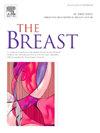三阴性乳腺癌无病进展预测模型的建立和验证:一项使用彩色多普勒超声和磁共振成像的回顾性研究
IF 7.9
2区 医学
Q1 OBSTETRICS & GYNECOLOGY
引用次数: 0
摘要
目的三阴性乳腺癌预后较差,辅助强化治疗可有效改善其预后。如何做出准确的决策是缺乏研究的。本研究旨在建立并验证一种利用乳腺彩色多普勒超声和磁共振成像(MRI)预测三阴性乳腺癌(TNBC)无病进展的模型,以促进临床干预的准确性。方法回顾性分析2018年6月至2022年6月期间380例TNBC患者的资料。收集的变量包括患者人口统计学、病理特征和影像学参数。通过Cox回归分析、随机森林和极端梯度增强(eXtreme gradient boosting, XGBoost)进行变量选择,建立预测模型。采用受试者工作特征(ROC)曲线、ROC曲线下面积(AUC)值、校准曲线以及净重分类改善和综合判别改善(IDI)等指标来评估模型的性能。将优化后的模型可视化并进行临床试验。结果对比分析表明,Cox模型优于Rf模型。cox和XGBoost。cox模型。具体来说,在验证集中的48个月时间点上,XGBoost。cox模型表现出较差的性能。选择Cox模型作为最优模型,该模型包含年龄、T-Stage、N-Stage、Ki-67、SE-Score、时间信号强度曲线和早期增强7个变量。训练集的AUC为0.937(0.904-0.971),验证集的AUC为0.906(0.855-0.957)。决策曲线分析和临床影响曲线支持该模型在指导临床干预方面的潜在效用。结论基于乳腺彩色多普勒超声和MRI成像参数的TNBC无病进展预测模型是可行的。建议进一步研究以证实其临床适用性。本文章由计算机程序翻译,如有差异,请以英文原文为准。
Development and validation of a predictive model for disease-free progression in triple-negative breast cancer: A retrospective study using color Doppler ultrasound and magnetic resonance imaging
Objective
Because triple-negative breast cancer has a poor prognosis, adjuvant intensive therapy can effectively improve its prognosis. How to make accurate decisions is lacking of research.This study aimed to develop and validate a model to predict disease-free progression in triple-negative breast cancer (TNBC) using breast color Doppler ultrasound and magnetic resonance imaging (MRI), to facilitate precision in clinical intervention.
Methods
A retrospective analysis was conducted on data from 380 individuals with TNBC between June 2018 and June 2022. Collected variables included patient demographics, pathological characteristics, and imaging parameters. Predictive models were developed using variable selection through Cox regression analysis, random forest, and eXtreme gradient boosting (XGBoost). Model performance was evaluated using receiver operating characteristic (ROC) curves, area under the ROC curve (AUC) values, calibration curves, and measures such as net reclassification improvement and integrated discrimination improvement (IDI). The optimal model was visualized and subjected to clinical testing.
Results
Comparative analysis revealed that the Cox model outperformed the Rf.cox and XGBoost.cox models. Specifically, at the 48-month time point in the validation set, the XGBoost.cox model demonstrated inferior performance compared to the Cox model. The Cox model was chosen as the optimal model, incorporating seven variables: Age, T-Stage, N-Stage, Ki-67, SE-Score, time-signal intensity curve, and early-phase enhancement. The AUC was 0.937 (0.904–0.971) in the training set and 0.906 (0.855–0.957) in the validation set. Decision curve analysis and clinical impact curve supported the potential utility of the model in guiding clinical interventions.
Conclusion
The predictive model for disease-free progression in TNBC, based on imaging parameters from breast color Doppler ultrasound and MRI, demonstrates feasibility. Further studies are recommended to confirm its clinical applicability.
求助全文
通过发布文献求助,成功后即可免费获取论文全文。
去求助
来源期刊

Breast
医学-妇产科学
CiteScore
8.70
自引率
2.60%
发文量
165
审稿时长
59 days
期刊介绍:
The Breast is an international, multidisciplinary journal for researchers and clinicians, which focuses on translational and clinical research for the advancement of breast cancer prevention, diagnosis and treatment of all stages.
 求助内容:
求助内容: 应助结果提醒方式:
应助结果提醒方式:


